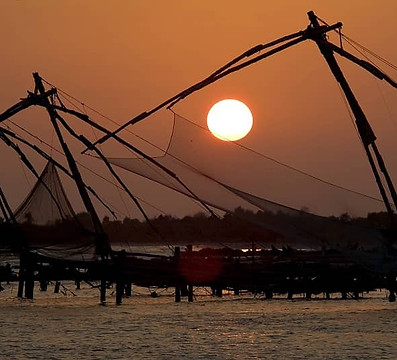Sights and landmarks of Kochi

Cochin, renamed Kochi and Kerala's premier tourist destination, sprawls across islands and promontories between the Arabian Sea and the Backwaters. Fort Kochi and Mattancherry are the main attractions where the city's complex history is reflected in an assortment of architectural styles. Spice markets, Chinese fishing nets, a synagogue, a Portuguese palace, the first European church in India and Dutch mansions: enough to do for a day's visit.
Until the beginning of the 14th century, Kodungallur, located about thirty kilometers northwest of Kochi, was the nerve center for local trade and merchants from China, the Middle East and Russia. In 1341, a flood moved traders to Kochi, which then emerged as one of India's main port cities. The Portuguese are the first to settle in Kochi, followed by the Dutch who will remain masters there until 1814 when the British regain control of the city.
Since then, Fort Kochi has been the historic center of the city. Strolling through the streets to discover the main sights and landmarks of Kochi is to immerse yourself in a European city of the 16th century.

JEWS STREET AND THE SYNAGOGUE
It was between the 11th and 13th centuries that Jewish refugees settled in Kochi. In 1568, they built a synagogue there which was destroyed in 1662 by the Portuguese. It was rebuilt by the Dutch and is today the oldest functioning synagogue in the nations of the Commonwealth. Inside, we discover a magnificent gold pulpit, multi-coloured glass chandeliers and lamps and a floor decorated with hand-painted tiles from China.
Jews Street, where the synagogue is located, was once populated by Jewish families. Only a few of them have remained; it is their stalls, handicraft and spice shops that you will find on your way during a stroll along this busy street in old Cochin.

KOCHI CHINESE FISHING NETS
They are locally known as "Cheena vala". Used by fishermen for over 500 years on the Kochi coastline, they may have been brought from Macau by the Portuguese who had a colony there or perhaps they were given to the Maharaja of Kochi by the Chinese Emperor Kubalagi in the 14th century. No one knows. Of the original 100 or so nets, only 12 remain in working condition today.
The walk along the coast is very pleasant, especially when you buy fresh fish and have it cooked by the local stalls, a speciality of Kochi.

THE DUTCH PALACE
Mattanchery Palace was built by the Portuguese in 1555 and offered to the Maharaja of Kochi for the purpose of obtaining trading privileges. Almost a century later, the Dutch reorganized the palace, hence its name "Dutch Palace".
The Hindu wall paintings, depicting various scenes from the Indian epics of Ramayana and Mahabharata as well as other Puranic legends, form the main attraction of the palace, as do the palanquins, the large ceilings and the attires of the royal family.

ST FRANCIS CHURCH OF KOCHI
It is the oldest church established by Europeans in India. It owes its origin to the Portuguese Franciscan friars. Several times transformed by the Dutch and ceded to the English in 1804, the church was renovated and renamed in 1886.
The charm and magnificence of the old world is visible on every element of the church: the wooden pulpit decorated with carvings, the confessional, the baptismal platform, the lecterns or the trunk.
The famous explorer Vasco da Gama, the first Portuguese sailor to reach the shores of Kerala, died in 1524 during his third visit to Kochi. It was in this church that he was buried, before being brought back to Portugal 14 years later. The location of his burial is clearly marked there.
